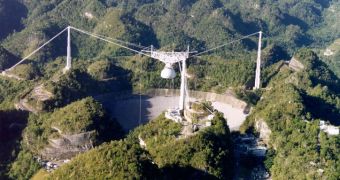Three citizens donating computer time to a research project are now credited with the discovery of a new pulsar in a constellation close to the Milky Way.
They were involved in the Einstein@Home initiative, which sees private individuals donating computer time on their own machines for studying a variety of cosmic objectives.
One such goal is the discovery of signals from radio pulsars, in batches of astronomical observations collected with the Arecibo Observatory.
The facility, which is operated by the US National Science Foundation (NSF), features the largest curved focusing dish ever built, and this gives it the largest electromagnetic-wave-gathering capacity ever.
It collects massive amounts of data from the night sky, as it slowly focuses its attention on various regions, depending on how the Earth orients.
The telescope is fixed, and cannot point its massive, 305-meter antenna all on its own. Scientists use it for a variety of studies.
It began procuring data for the Einstein@Home initiative in late 2009, and the new finding is the first large one to come out of it.
What the project does is basically used donated time from the home and office computers of 250,000 volunteers, using the machines' combined calculation power to search for interesting radio signals in the Universe.
The new finding is being credited to home scientists Chris and Helen Colvin, from Ames, Iowa, and Daniel Gebhardt, who is based at the Universitat Mainz, in Germany.
They discovered the new stellar structure in the Vulpecula constellation, which is located some 17,000 light-years away from our planet. The pulsar has been named PSR J2007+2722.
These objects are actually neutron stars spinning at high rates, in a plane perpendicular to our planet. This makes them appear as lighthouses on our telescopes.
Neutron stars appear when massive stars reach the end of their burning cycle and go supernova, but have insufficient mass to develop into a black hole.
“This is a thrilling moment for Einstein@Home and our volunteers. It proves that public participation can discover new things in our Universe. I hope it inspires more people to join us to help find other secrets hidden in the data,” explains Bruce Allen.
He is the leader of the Einstein@Home project, and holds a joint appointment as the director of the Max Planck Institute for Gravitational Physics and an adjunct professor of physics at the University of Wisconsin-Milwaukee.
Details of the new discovery appear in a paper entitled “Pulsar Discovery by Global Volunteer Computing,” which is published in the August 12 issue of the esteemed publication Science Express.
Follow me on Twitter @TudorVieru

 14 DAY TRIAL //
14 DAY TRIAL //